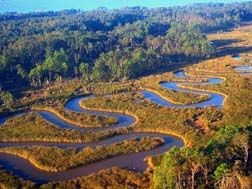
Charles D. Rafkind Colonial National Historical Park exists within a dynamic environment that has been defined and changed by both natural and human activity. The park's linear nature helps staff to manage its natural resources as a single unit. However, just beyond the park's narrow borders, residential and commercial development affects the park's land as well as the waters that flow through the park. Controlling ground and surface water quality, coping with the spread of invasive species, and preventing erosion along streams and rivers continue to be challenges. Weather and climate change are the biggest factors in the future character and preservation of the park. Located between two rivers, the park often suffers from storm damage. In 2003, Hurricane Isabel caused extensive damage, uprooting many trees. During the incoming tidal cycle storm winds pushed the tidal water high enough that the water pushed the wooden bridge decking off its piers and move the decking 75 feet upstream. Two winter storms and Hurricane Irene in 2011 did further shoreline damage. Ice storms can bend and break limbs of the tallest trees. Each heavy negative impact on the shoreline and the forest opens up new opportunities for invasive species to spread or be introduced, compromising important habitats that support rare or threatened species. Climate change models show that storms will increase in severity and the sea level will continue to rise. The park is monitoring a number of ecosystems to track the changes and to develop management strategies for adapting to forces it cannot change. |
Last updated: September 12, 2022
